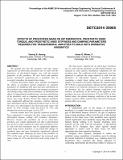| dc.contributor.author | Narang, Yashraj Shyam | |
| dc.contributor.author | Winter, Amos | |
| dc.date.accessioned | 2015-08-26T17:20:41Z | |
| dc.date.available | 2015-08-26T17:20:41Z | |
| dc.date.issued | 2014-08 | |
| dc.identifier.isbn | 978-0-7918-4636-0 | |
| dc.identifier.uri | http://hdl.handle.net/1721.1/98255 | |
| dc.description.abstract | We quantify how the hip energetics and knee torque required for an above-knee prosthesis user to walk with the kinematics of able-bodied humans vary with the inertial properties of the prosthesis. We also select and optimize passive mechanical components for a prosthetic knee to accurately reproduce the required knee torque.
Previous theoretical studies have typically investigated the effects of prosthesis inertial properties on energetic parameters by modifying both mass and mass distribution of the prosthesis and computing kinetic and energetic parameters only during swing. Using inverse dynamics, we determined the effects of independently modifying mass and mass distribution of the prosthesis, and we computed parameters during both stance and swing. Results showed that reducing prosthesis mass significantly affected hip energetics, whereas reducing mass distribution did not. Reducing prosthesis mass to 25% of the mass of a physiological leg decreased peak stance hip power by 26%, average swing hip power by 74%, and absolute hip work over the gait cycle by 22%.
Previous studies have also typically optimized prosthetic knee components to reproduce the knee torque generated by able-bodied humans walking with normative kinematics. However, because the prosthetic leg of an above-knee prosthesis user weighs significantly less than a physiological leg, the knee torque required for above-knee prosthesis users to walk with these kinematics may be significantly different. Again using inverse dynamics, it was found that changes in prosthesis mass and mass distribution significantly affected this required torque. Reducing the mass of the prosthesis to 25% of the mass of the physiological leg increased peak stance torque by 43% and decreased peak swing torque by 76%.
The knee power required for an above-knee prosthesis user to walk with the kinematics of able-bodied humans was analyzed to select passive mechanical components for the prosthetic knee. The coefficients of the components were then optimized to replicate the torque required to walk with the kinematics of able-bodied humans. A prosthetic knee containing a single linear spring and two constant-force dampers was found to accurately replicate the targeted torque (R[superscript 2]=0.90 for a typical prosthesis). Optimal spring coefficients were found to be relatively insensitive to mass alterations of the prosthetic leg, but optimal damping coefficients were sensitive. In particular, as the masses of the segments of the prosthetic leg were altered between 25% and 100% of able-bodied values, the optimal damping coefficient of the second damper varied by 330%, with foot mass alterations having the greatest effect on its value. | en_US |
| dc.description.sponsorship | MIT Department of Physics Pappalardo Program (Fellowship) | en_US |
| dc.description.sponsorship | MIT Public Service Center Fellowship | en_US |
| dc.description.sponsorship | National Science Foundation (U.S.). Graduate Research Fellowship (1122374) | en_US |
| dc.description.sponsorship | MIT Tata Center for Technology and Design | en_US |
| dc.language.iso | en_US | |
| dc.publisher | ASME International | en_US |
| dc.relation.isversionof | http://dx.doi.org/10.1115/DETC2014-35065 | en_US |
| dc.rights | Creative Commons Attribution-Noncommercial-Share Alike | en_US |
| dc.rights.uri | http://creativecommons.org/licenses/by-nc-sa/4.0/ | en_US |
| dc.source | Prof. Winter via Angie Locknar | en_US |
| dc.title | Effects of Prosthesis Mass on Hip Energetics, Prosthetic Knee Torque, and Prosthetic Knee Stiffness and Damping Parameters Required for Transfemoral Amputees to Walk With Normative Kinematics | en_US |
| dc.type | Article | en_US |
| dc.identifier.citation | Narang, Yashraj S., and Amos G. Winter. “Effects of Prosthesis Mass on Hip Energetics, Prosthetic Knee Torque, and Prosthetic Knee Stiffness and Damping Parameters Required for Transfemoral Amputees to Walk With Normative Kinematics.” Volume 5A: 38th Mechanisms and Robotics Conference (August 17, 2014). | en_US |
| dc.contributor.department | Massachusetts Institute of Technology. Department of Mechanical Engineering | en_US |
| dc.contributor.mitauthor | Narang, Yashraj Shyam | en_US |
| dc.contributor.mitauthor | Winter, Amos | en_US |
| dc.relation.journal | Volume 5A: 38th Mechanisms and Robotics Conference | en_US |
| dc.eprint.version | Author's final manuscript | en_US |
| dc.type.uri | http://purl.org/eprint/type/ConferencePaper | en_US |
| eprint.status | http://purl.org/eprint/status/NonPeerReviewed | en_US |
| dspace.orderedauthors | Narang, Yashraj S.; Winter, Amos G. | en_US |
| dc.identifier.orcid | https://orcid.org/0000-0002-4151-0889 | |
| mit.license | OPEN_ACCESS_POLICY | en_US |
| mit.metadata.status | Complete | |
